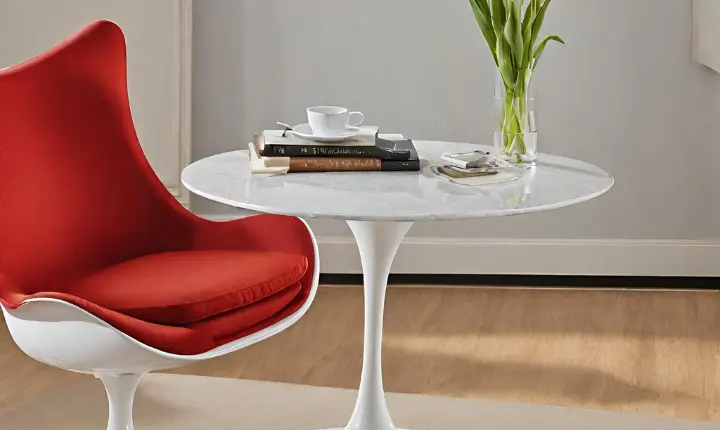The Mid-Century Tulip Table and Chairs
The mid-century tulip table and chairs have a classic style that works well with a variety of interior decor themes. This set of furniture exudes a subtle elegance whether it is positioned in an eclectic setting, a modern one, or a space with retro influences. Its adaptability extends beyond aesthetics, making it a practical choice…
The mid-century tulip table and chairs have a classic style that works well with a variety of interior decor themes. This set of furniture exudes a subtle elegance whether it is positioned in an eclectic setting, a modern one, or a space with retro influences. Its adaptability extends beyond aesthetics, making it a practical choice for those seeking space-saving solutions without compromising on style.
Single Pedestal Base:
The defining feature of the tulip table is its single, sturdy pedestal base. The streamlined design not only offers visual simplicity but also provides more legroom for those seated around the table. The absence of traditional legs contributes to an open and uncluttered feel in any space.
Organic Form:
The tulip table’s base takes inspiration from the organic form of a tulip flower, with a smooth, curved structure that adds a touch of elegance to the overall design. This distinctive feature sets it apart from other tables of its time and adds a sculptural element to the piece.
Versatility in Materials:
Saarinen’s original tulip table featured a moulded fibreglass top, but as the design gained popularity, variations with marble, laminate, and other materials became available. This versatility allows homeowners to choose a material that suits their aesthetic preferences and complements their interior design.
Key Features of the Tulip Chairs:
Unified Design Aesthetic:
The tulip chairs were specifically designed to complement the tulip table, featuring a similar single pedestal base. This unified design aesthetic creates a cohesive and harmonious look in dining spaces.
Comfortable Seating:
Despite its minimalist appearance, the tulip chair offers a surprisingly comfortable seating experience. The shell-shaped seat, often upholstered for added comfort, cradles the occupant while providing support.
Swivel Functionality:
An innovative feature of the tulip chair is its swivel functionality. This adds a playful element to the design while also making it easy for individuals to turn and engage in conversations, further enhancing the social aspect of dining and entertaining.
Pros:
- Timeless Design:
The mid-century tulip table and chairs feature a timeless and iconic design that has endured for decades. The clean lines and simple, yet elegant shapes contribute to a classic aesthetic that fits well in various interior styles.
- Space Saving:
The tulip table typically comes with a pedestal base instead of the traditional four legs. This design can save space and provide more legroom, making it ideal for smaller dining areas or apartments.
- Versatility:
The minimalist design of the mid-century tulip table and chairs makes them versatile. They can complement a range of interior styles, from modern to eclectic, making it easier to integrate into existing decor.
- Easy to Clean:
The smooth surfaces of the tulip table and chairs are generally easy to clean. This is especially advantageous in a dining setting where spills are likely to occur.
- Comfortable Seating:
The chairs often come with cushioned seats, providing comfort during long meals or gatherings. The ergonomic design of the chairs can also enhance the overall dining experience.
Cons:
- Cost:
Authentic mid-century modern furniture can be expensive, and even reproductions with quality materials may come with a significant price
Limited Customization:
- The iconic design may limit customization options. If you prefer a highly personalized look, the mid-century tulip table and chairs may not offer the variety you desire.
Maintenance of Cushions:
- While cushioned seats provide comfort, they may require more maintenance over time. Stains or wear on upholstery may necessitate more frequent cleaning or reupholstering.
Ideal for Large Groups:
- The compact design of the table may not be suitable for large gatherings or family events where a bigger dining surface is needed.
Trend Saturation:
- The mid-century modern trend has become very popular, leading to saturation in the market. As a result, the distinctive look of the tulip table and chairs may be commonplace, and some individuals may prefer more unique or less ubiquitous styles.
FAQs
Q. What is the mid-century tulip table and chairs?
- The mid-century tulip table and chairs refer to a furniture set that gained popularity during the mid-20th century. It is characterized by a sleek and minimalist design, with the table featuring a single pedestal base and the chairs often having a distinctive tulip-shaped base.
Q. What are the advantages of the mid-century tulip table and chairs?
- Some advantages include a timeless design, space-saving features, versatility in fitting various interior styles, ease of cleaning, comfortable seating, and durability.
Q. Are there any downsides to the mid-century tulip table and chairs?
- Some potential downsides include the cost, limited customization options, maintenance requirements for cushioned seats, potential impracticality for large gatherings, trend saturation, and the weight of the furniture.
Q. Is the mid-century tulip table and chairs suitable for small spaces?
- Yes, the space-saving design of the tulip table with its pedestal base makes it a great choice for smaller dining areas or apartments.
Q. How do I maintain the cushioned seats on the chairs?
- Regular vacuuming and spot cleaning can help maintain the upholstery on the cushioned seats. Some chairs may also have removable and washable covers.
Conclusion
While the mid-century tulip table and chairs boast numerous advantages, it’s essential to consider factors such as cost, limited customization options, and the potential need for maintenance. The decision to invest in this furniture should align with individual preferences, budget constraints, and the specific requirements of the living space.






